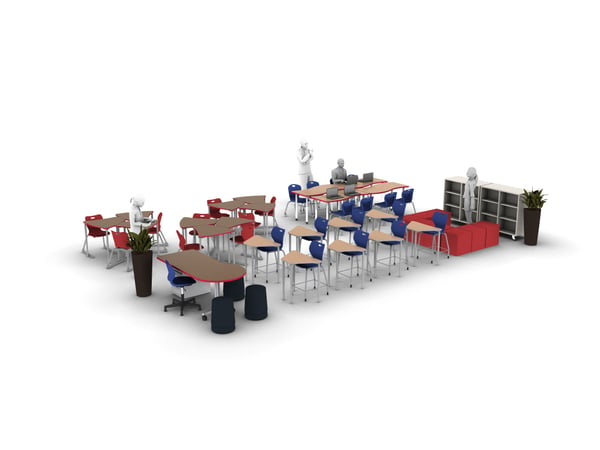Education manufacturers rely on showcasing their products in The KITS Collaborator so their teams can show stunning, inspired layouts to prospects every day. We love seeing the way that contract furniture can impact future learning for k-12 students and help shape the way they learn. We’ve rounded up some key 2023 education design trends that salespeople can use to help present their solutions and ensure they are giving the best options to their clients.
Themes in Education Design Trends for 2023
Functionality is Always on Trend
There can be an overwhelming number of design trends to consider for different educational philosophies. And while they’re important, clients sometimes jump to things like incorporating plants and the natural world or color schemes before looking at function first. So encourage your clients to focus on goals and budget first. You can use tools like KITS to show them the same space in multiple color schemes, later on.

Classroom Color Trends
Ok, but we all know your clients are going to ask you about color. 2023 education design trends are about bringing the natural world and more calming spaces into the classroom, so lots of blues and greens. But creative use of color can help define zones or subjects in a classroom. And we can combine color choices with the ideas around functionality when we use a consistent color to indicate a chair size, or grade level. While clients sometimes like the idea of energetic bright colors, neutrals are more on trend to create a blank canvas for classrooms to post and share different kinds of work. The location of the school should also be taken into account - darker or rainier climates may benefit from more use of color. Above all, as we consider sustainability and budget, color choices should stand the test of time and avoid trendy colors of the year. Colors should also work throughout the building with its wall and flooring selections as furniture may easily move between rooms in the future.

The Home-Like Trend in Education Design
Much like office styles, education design trends are working to incorporate home-like spaces in schools. They reduce student stress and create more comfortable environments, especially after many students experienced online learning from their homes in 2020-2021. The key is to find the balance - movement and comfort don’t necessarily mean ‘relaxing’. Keeping the space educational is key. One way to incorporate an appropriate difference between school and home is to ensure that furniture layouts maximize engagement vs. isolation - group work, and traffic flow take center stage over the rigid desks of the past.
Movement
The formality of where furniture is placed isn’t the only area that has changed in education. Furniture that lets students move is on the rise as educators realized that movement doesn’t always mean a lack of focus. In fact, multiple studies show us that students learn with their brain and their bodies. Flexible, ergonomic seating that allows for shifting is now key to classroom comfort. Flexible furniture can be a concern because many schools need to be able to move, stack and re-purpose items so show your clients how adaptable furniture need not mean soft seating alone. Consider elements like standing desks, and writable spaces on walls and more that allow for moving while working in groups.
Technology Considerations
Education incorporates more technology today than ever before, from even the youngest learning environments. While we can’t plan for what future elements will bring, incorporating large screens for presentations, and space for growing media tools like cameras and microphones, VR and 3D printers rely on flex space with lots of planning for power and cable management. Tech should live in a hub area but be able to be used anywhere.

Safety
Cleaning procedures are top of mind like never before, so selecting materials which can be sanitized is top of mind for many clients. Windows should be operable as well to creating venting and air circulation, and may be incorporated between classrooms or overlooking hallways as well. Eyes on what’s happening outside the classroom can contribute to a sense of community in the school and help lower feelings of isolation - and even instances of bullying.
Let’s Not Forget the Staff
The learning environment in any school is largely driven by the staff. Education design must go beyond the classroom to create spaces where staff can recharge, problem-solve and share ideas. So we can’t leave them out of a discussion on important education design trends. Staff areas should be a calm zone, typically in blue and green color schemes. You should also look to provide spaces for collaboration and communal seating. A space with modular seating allows staff to brainstorm and problem-solve. But it should also be a space where they can re-charge, so spaces for snacks, coffee and eating packed lunches from home need to be included too. If room allows, a space for focussed work is also useful, not only for marking or planning but for the times when staff are on break and need to catch up on personal stuff - like making a medical appointment or checking in on their own kids. But it shouldn’t be out of tune with the rest of the school - students and teachers should feel like a team, so incorporate school branding and colors in small ways, even in hidden staff areas.
Show it all off with KITS
The KITS collaborator can help you build layouts with more than 90 digital catalogs, including many educational manufacturers. When you build a school layout with KITS, you can immerse your clients in VR and AR easily to truly see their educational spaces come to life. Plus, you can re-specify finishes and color with a few clicks, and leave your client with a project summary sheet in no time. It’s everything you need to sell education furniture in one meeting. Learn how our friends at Artcobell use KITS to meet client needs. And schedule your KITS demo, today.



